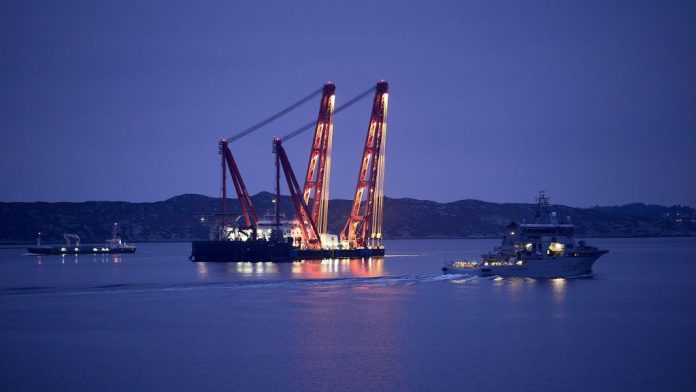“Gulliver” has arrived to the accident area – the sister ship is on its way.
The slightly smaller “Rambiz” is in the North Sea, heading towards Hanøytangen. Together, the two cranes can lift 7300 tonnes.
In the light of the dark, the Luxembourg-flagged “Gulliver” sailed into Hjeltefjorden on Sunday morning, at a speed of around 5 knots – or more than 9 kilometers per hour.
The crane boat was at Hanøytangen just before 09:00 on Sunday morning.
Can lift 4000 tons
The boat has sailed to KNM “Helge Ingstad” in Hjeltefjorden, near Bergen, Norway,
Data from MarineTraffic shows that the sister ship “Rambiz” is also heading for Hanøytangen. The crane boat is located in the middle of the North Sea, and is scheduled to arrive on Hjeltefjorden on Wednesday.
There have been many speculations about how the ship is to be raised. Norwegian Armed Forces have given few details besides that “the plan is to gradually lift the vessel and transfer it to a submersible barge”.
Torill Herland, communications chief of the defense, confirms that “Gulliver” is in Hjeltefjorden in connection with rescue work. However, she will not share more details about this Sunday morning.
Frigate “Helge Ingstad” weighs more than 5000 tonnes and is also filled with water. Only the radar tower is visible, the boat is about 20 meters high.
Has been involved in several rescue operations
Boa and Scaldis Salvage and Marine Contractors have previously worked together, according to Boa’s website.
“Boabarge 33” and “Rambiz” were both used when the construction of the North Sea One Windfarm offshore windshield was transported from Denmark in May 2016.
Individually, they have participated in several rescue operations, and Boa’s barges have been turning around several places in the world.
In August, the Trondheim company’s “Boabarge 29” had a central role in the rescue of the barge “Derrick barge DB1”, which sank in the Gulf of Mexico last year.
According to Boa, it was the heaviest rescue conducted on the American continent.
Scaldis Salvage have also participated in several storage operations, including the “Tricolor” ship in the English Channel, according to their own websites.
KNM “Helge Ingstad” will be raised gradually before it is transferred to a submersible barge and towed to Haakonsvern.

The Armed Forces have been working hard to secure the ship, to prevent the frigate from sinking more.
On Saturday, communications officer, Torill Herland, told the Norwegian site BT that there is a real danger that the frigate will sink further. Her concern is that the weather might cause the ropes that keep the ship up, to bust.
Parts of the fuse have already busted.
“If the ship slides even further down into the water and stays on the firm bottom, it will be challenging to get the fastenings placed underneath the ship,” said Herland.
At the same time, the Coastal Administration stated that the ship’s fuel stock was larger than initially assumed.
– The vessel is not stable. It is our starting point. That is why we use large resources to collect oil, said Johan Marius Ly, Deputy Director at the Coastal Administration.
Bringing in the heavies
“Gulliver” and “Rambiz” are among the largest lifting vessels.
The largest, “Thialf” and “Saipem 7000”, have a capacity of 14,000 tonnes.
Communications manager, Michelle Brama of Heerema, owner of “Thialf” and several other lifting vessels, told tghe publication, Sysla, that they have not been contacted in this case.
Of the lifting vessels currently in Norway, the Norwegian shipping company J.J. Ugland’s “HLV Owl” is the largest, with a lifting capacity of 800 tons.
It is currently located in Stavanger, but has not been contracted.











